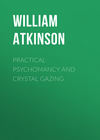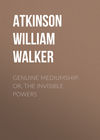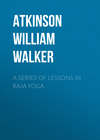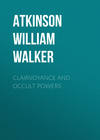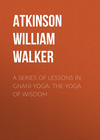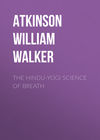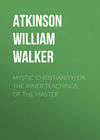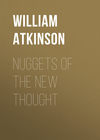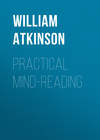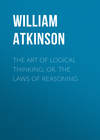Kitabı oku: «Practical Psychomancy and Crystal Gazing», sayfa 4
LESSON V.
PSYCHOMETRY
The phenomena commonly known as "Psychometry," is but one phase of Psychomancy – or it even may be said to be but a method employed to bring into action the Astral Senses. The Psychometrist merely gets into rapport with the distant scene; or period of time; or person; or object; by using some bit of physical material associated with that scene; time; person; objects; etc., in order to "open up communications" along the usual lines of Psychomancy. This has been compared to the use of objects associated with a thing in the case of memory. We all know how the sight of some object will recall at once memories of things long since forgotten to all appearances, but which memories have been merely stored away in the great storehouse of the mind, to be recalled readily when the "association" is furnished. What "association" is in the case of Memory, so is the material object presented as the "associated object" in Psychometry.
The Occult Teachings inform us that there is a psychic connection ever existing between things once associated, and that when we throw ourselves into the psychic current surrounding an object we may readily follow the current back until we reach the associated object for which we are seeking on the Astral Plane. In the Akashic Records (See Lesson IX) all memories are registered and recorded, and if we have a good starting point we may travel back until we find that which we desire. In the same way the "associated object" furnishes us with a ready means of starting our Astral Tube into being and use. This is the secret of the use of the lock of hair; the bit of clothing; the piece of metal or mineral, etc., used by Psychometrists.
A well known authority on the subject has said concerning Psychometry: "It may be asked how it is possible, amid the bewildering confusion of these records of the past, to find any particular picture when it is wanted. As a matter of fact, the untrained psychic usually cannot do so without some special link to put him in rapport with the subject required. Psychometry is an instance in point, and it is quite probable that our ordinary memory is really only another presentment of the same idea. It seems as though there were a sort of magnetic attachment or affinity between any particle of matter and the record which contains its history – and affinity which enables it to act as a kind of conductor between that record and the faculties of anyone who can read it. For instance, I once brought from Stonehenge a tiny fragment of stone, not larger than a pin's head, and on putting this into an envelope and handing it to a psychometrist who had no idea what it was, she at once began to describe the wonderful ruin from which it came, and the desolate country surrounding it, and then went on to picture vividly what were evidently scenes from its early history, showing that the infinitesimal fragment had been sufficient to put her into communication with the records connected with the spot from which it came. The scenes through which we pass in the course of our life seem to act in the same manner upon the cells of our brain as did the history of Stonehenge upon that particle of stone; they establish a connection with those cells by means of which our mind is put in rapport with that particular portion of the records, and so we 'remember' what we have seen."
THE FIVE METHODS
The method of Psychometry may be employed in a number of ways, among which are the following, all of which are subject to many variations and combinations:
1. Locating a person by means of a lock of hair, article of clothing, handkerchief, ribbon, piece of jewelry, bit of writing, etc. In this manner not only may a good Psychometrist locate the person, but will also be able to give an idea of his characteristics, habits, health, etc.
2. Describing a person's characteristics, past life, future, etc., by means of the rapport condition made possible by the person's presence.
3. Describing a present distant scene by means of a bit of mineral, plant, or similar object once located at the place.
4. Describing the surrounding underground characteristics by means of a bit of mineral, etc.
5. Getting into touch with the past history of an object, or its surroundings, by means of the object itself. For instance, a bullet from the battle-field may give the history of the battle; a bit of ancient pottery, the characteristics and habits of the people who made or used it, as well as the appearance of the land in which they dwell, etc.
In all of these phases, with their variations and combination, the student will see the operation of the phenomena under the various heads as classified by us in this work. Each Occurrence or manifestation will be found to fit into the class of Simple Psychomancy; Space Psychomancy; Past Time Psychomancy; or Future Time Psychomancy.
(See Lesson II, for suggestions regarding development of Psychometric power.)
LESSON VI.
CRYSTAL GAZING
There has been a great revival of interest in the subject of "Crystal Gazing," particularly in England, of late years, and many interesting accounts have appeared in the papers and magazines regarding the results of the experiments. But the majority of the writers on the subject persist in treating it as a thing separate and apart from other forms of Psychomancy – in fact, many of them ignore Psychomancy altogether and are apparently under the impression that there is no connection between it and their favorite subject of Crystal Gazing. This attitude is somewhat amusing to persons who have made a careful study of Psychic Phenomena and who know that Crystal Gazing is not a distinct phenomenon, but is merely a method of bringing into action the Psychomantic faculties.
In many respects the Crystal acts in a manner akin to that of the "associated object" in Psychometry, but there is one point of distinction which should not be overlooked by the student. The "associated object" gives to the Psychometrist a starting point for the Astral Tube, and also serves to "point the Astral Telescope" (if one may use the term) in the right direction, by reason of its affinity with the distant scene, etc. But the Crystal does not so act, for it is not closely allied to, or in sympathy with other things, when used in the ordinary manner. Instead of being the "eye-lens of the telescope," it is really a "Magic Mirror" which is turned first this way and that, and which reflects whatever comes within its field, just as does any other mirror. The trained and developed Psychomancer, however, may direct his Mirror to any desired point, and may hold it there by means of a concentrated Will.
The favor with which Crystal Gazing meets with at the hands of beginners is due to the fact that it is the easiest method known by which the Astral Vision may be awakened. With the majority of people, the power may be awakened only by the aid of some physical object which may act as a starting-point for the Astral Tube, or as one writer has expressed it, "a convenient focus for the Will-power." A number of objects may be so employed, but the Crystal or Glass Ball is the best for the purpose because of certain atomic and molecular arrangements which tend to promote the manifestation of the psychic power and faculties.
Crystal Gazing, as a method for inducing Psychomantic vision, has been quite common among all peoples, in all times. Not only the Crystal but many other objects are similarly used. In Australia the native priests use water and shining objects, or in some cases, flame. In New Zealand some of the natives use a drop of blood. The Fijians fill a hole with water, and gaze into it. Some South American tribes use the polished surface of a black stone. The American Indians used water and shining bits of flint or quartz. And so the story goes. As Lang states it, people "stare into a crystal ball; a cup; a mirror; a blot of ink (Egypt and India); a drop of blood (the Maoris of New Zealand); a bowl of water (American Indians); a pond (Roman and African); water in a glass bowl (Fez); or almost any polished surface, etc."
We quote a typical case of Crystal Gazing, related by Mr. Andrew Lang. He says:
"I had given a glass ball to a young lady, Miss Baillie, who had scarcely any success with it. She lent it to Miss Leslie, who saw a large, square, old-fashioned red sofa covered with muslin (which she afterward found in the next country-house she visited). Miss Baillie's brother, a young athlete, laughed at these experiments, took the ball into his study, and came back looking 'gey gash.' He admitted that he had seen a vision – somebody he knew, under a lamp. He said he would discover during the week whether he saw right or not. This was at 5:30 on a Sunday afternoon. On Tuesday, Mr. Baillie was at a dance in a town forty miles from his home, and met a Miss Preston. 'On Sunday,' he said, 'about half-past five, you were sitting under a standard lamp, in a dress I never saw you wear, a blue blouse with lace over the shoulders, pouring out tea for a man in blue serge, whose back was towards me, so that I only saw the tip of his moustache.' 'Why, the blinds must have been up,' said Miss Preston. 'I was at Dulby,' said Mr. Baillie, and he undeniably was."
Stead relates the following experience with the Crystal: "Miss X. upon looking into the crystal on two occasions as a test, to see if she could see men when she was several miles off, saw not me, but a different friend of mine on each occasion. She had never seen either of my friends before, but immediately identified them both on seeing them afterward at my office. On one of the evenings on which we experimented in the vain attempts to photograph a Double, I dined with Madam C. and her friend at a neighboring restaurant. As she glanced at the water bottle, Madame C. saw a picture beginning to form, and, looking at it from curiosity, described with considerable detail an elderly gentleman whom she had never seen before, and whom I did not in the least recognize from her description at the moment. Three hours afterwards, when the seance was over, Madam C. entered the room and recognized Mr. Elliott, of Messrs. Elliott & Fry, as the gentleman whom she had seen and described in the water bottle at the restaurant. On another occasion the picture was less agreeable: it was an old man lying dead in bed with some one weeping at his feet; but who it was, or what it related to, no one knew."
As a matter of general interest, we also quote Mr. Stead's remarks on crystal gazing, which agree with our own views and experience. He says: "There are some people who cannot look into an ordinary globular bottle without seeing pictures form themselves, without any effort or will on their part, in the crystal globe. Crystal gazing seems to be the least dangerous and most simple of all forms of experimenting. You simply look into a crystal globe the size of a five-shilling piece, or a water bottle which is full of clear water, and which is placed so that too much light does not fall upon it, and then simply look at it. You make no incantations, and engage in no mumbo-jumbo business; you simply look at it for two or three minutes, taking care not to tire yourself, winking as much as you please, but fixing your thought upon whatever you wish to see. Then, if you have the faculty, the glass will cloud over with a milky mist, and in the centre the image is gradually precipitated in just the same way as a photograph forms on the sensitive plate."
(See Lesson II, for further particulars on Crystal Gazing, and suggestions for the successful development of the power.)
LESSON VII.
ASTRAL PROJECTION
In our last three lessons we considered that class of Psychomancy arising from the erection and employment of the "Astral Tube." In the present lesson we pass to a consideration of the third class of phenomena, namely, that occasioned by the actual projection of one's Astral Body to distant points.
In this class of phenomena the consciousness of the person does not remain within the physical organism, but is actually projected along with the Astral Body to the point being psychically viewed or examined. This form of Psychomancy is, of course, a higher degree of manifestation than the class previously described. Here physical consciousness is temporarily suspended (perhaps for but a moment or so) and the Astral Body containing the consciousness of the individual is projected to some point, perhaps far distant, with the rapidity of thought, where it examines objects there situated, receiving sensations through and by means of the Astral Senses. This phenomena may arise while the person is in a trance, or sleep, etc., or else in a moment of concentrated abstraction, when one is "day-dreaming"; in a "brown study"; or "wrapped in thought," as the familiar terms run. When he returns to his physical body he "comes to himself," and what he has seen or heard seems to him like a "day-dream" or fantasy – unless he be a trained seer, in which case the two planes of consciousness will be closely related, and almost continuous.
Besides the more familiar phases of this class of phenomena, there are wonderful possibilities open for the developed Psychomancer along these lines. As a leading writer on this subject has said concerning it: "He has also the immense advantage of being able to take part, as it were, in the scenes which come before his eyes. If, in addition, he can learn how to materialize himself, he will be able to take part in physical events or conversations at a distance, and to show himself to an absent friend at will."
The trained experimenter along these lines has also the advantage of being able to search about on the Astral Plane for what he desires to find or locate. He is able to direct his Astral Body to definite places, either by means similar to finding one's way on the physical plane, or else by following up the psychic clue afforded by a piece of clothing, a lock of hair, a piece of stone, or some other object connected with the person or place desired, by means of a higher form of Psychometry. Of course, the person whose powers are not so highly developed is not able to have such control over his Astral Body, or to manifest such a degree of trained power. He is like a child learning to walk, or read – he is awkward, and must learn to direct his movements. There are many degrees of power, from the occasional, spontaneous manifestations, to those of the highly trained Occultists who travel in the Astral even more easily than in the physical, and with the same degree of certainty and control.
The pages of reliable works on Occultism and Psychic Research are filled with illustrations and examples of cases along these lines, in which the Astral Body of persons have traveled to distant scenes, and have reported occurrences and scenes witnessed there, sometimes materializing so as to be seen by the persons in the places visited. We herewith mention a few of these cases, in order to illustrate the principle.
A well-known example is that of the Philadelphian, mentioned by the German writer Jung Stilling, and quoted by some English writers. The man in question was a well-known character, respected, of good reputation and steady habits. He had the reputation of possessing Psychomantic powers which he sometimes manifested for the benefit of friends and others. He was once consulted by the wife of a sea captain, whose husband was on a voyage to Europe and Africa, and whose vessel had been long overdue, and from whom no tidings had been received for a long time.
The Psychomancer listened to the story of the anxious and distressed wife, and then excused himself from the room for a short time, retiring into an adjoining room. Becoming alarmed at his continued absence from the room, the lady quietly opened the connecting door, and peeped in the second room, where much to her surprise and alarm she saw the old man lying on a couch, showing all the appearances of death. She waited in great alarm for a long time, when he aroused himself and returned to her. He told her that he had visited her husband in a coffee-house in London, and gave her the reasons for his not having written, adding that he would soon return to Philadelphia.
When the husband finally returned, his wife questioned him regarding the matter, and he informed her that the reasons given by the Psychomancer were correct in every detail. Upon being taken into the presence of the man, the old sea captain uttered an exclamation of surprise, saying that he had seen the man on a certain day in a coffee-house in London, and that the man had told him that his wife was worried about him, and that he had answered the man, saying that he had been prevented from writing for certain reasons, and that he was on the very eve of setting sail for America. He said that he had then lost sight of the stranger suddenly.
W. T. Stead relates the case of a lady of his acquaintance who has spontaneously developed the power to travel in her Astral Body, and to materialize the same unconsciously. She became a source of great worry and distress to many of her friends, to whom she would pay unexpected and involuntary visits, frightening them out of their wits by the materialization of what they supposed must be the "ghost" of the lady, whom they thought must have died suddenly. The occurrences, however, became so frequent that her friends at last became familiar with the nature of the appearances, and viewed them with merely great interest and wonder.
The English Society for Psychical Research have several hundred well-authenticated instances of such appearances in their published records. One of the well-known cases is that of a gentleman described as "S. H. B.," a member of the London Stock Exchange, and a man of considerable business note. He relates his story as follows:
"One Sunday night in November, 1881, I was in Kildare Gardens, when I willed very strongly that I would visit in the spirit two lady friends, the Misses V., who were living three miles off, in Hogarth Road. I willed that I should do this at one o'clock in the morning, and having willed it, I went to sleep. Next Thursday, when I first met my friends, the elder lady told me she woke up and saw my apparition advancing to her bedside. She screamed and woke her sister, who also saw me." (A signed statement of the two sisters accompanies this statement, both ladies fixing the time at one o'clock, and saying that Mr. B. wore evening dress.)
"Again, on December 1, 1882, I was at Southall. At half-past nine I sat down to endeavor to fix my mind so strongly upon the interior of a house at Kew, where Miss V. and her sister lived, that I seemed to be actually in the house. I was conscious, but was in a kind of mesmeric sleep. When I went to bed that night, I willed to be in the front bedroom of that house at Kew at twelve, and to make my presence felt by the inmates. Next day I went to Kew. Miss V.'s married sister told me, without any prompting from me, that she had seen me in the passage going from one room to another at half-past nine o'clock, and that at twelve, when she was wide awake, she saw me come to the front bedroom, where she slept, and take her hair, which is very long, into my hand. She said I then took her hand and gazed into the palm intently. She said, 'You need not look at the lines, for I never had any trouble.' She then woke her sister. When Mrs. L. told me this. I took out the entry that I had made the previous night and read it to her. Mrs. L. is quite sure she was not dreaming. She had only seen me once before, two years previously, at a fancy ball."
"Again, on March 22, 1884, I wrote to Mr. Gurney, of the Psychical Research Society, telling him I was going to make my presence felt by Miss V., at 44 Norland Square, at midnight. Ten days afterwards, I saw Miss V., when she voluntarily told me that on Saturday at midnight, she distinctly saw me, when she was quite wide awake."
We have related these accounts in order to show instances of the appearance of a materialized Astral Body. But, we must remember that these cases of materialization are very rare as compared to the cases of Astral Projection (without materialization) in ordinary Clairvoyance. And yet the phenomena is practically the same in both instances, leaving out the phase of materialization. In many instances the individual actually travels in his Astral Body to the distant scene and there witnesses the events occurring at that point. There is a "ghost" within each one of us, which under certain favorable conditions travels away from our physical body and "sees things" at far-off points. Under certain other conditions it materializes, and is visible to others, but in the majority of cases it merely "sees" without being seen. The Psychomancer, in this phase of the phenomena, actually travels from the location of the physical body, to the other points desired, and reports what he or she sees and hears there.
